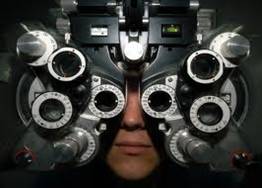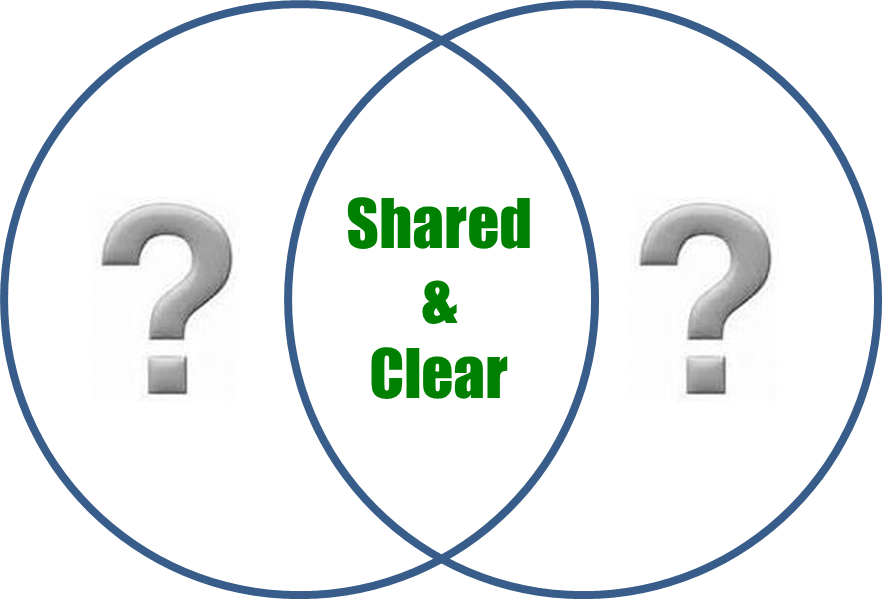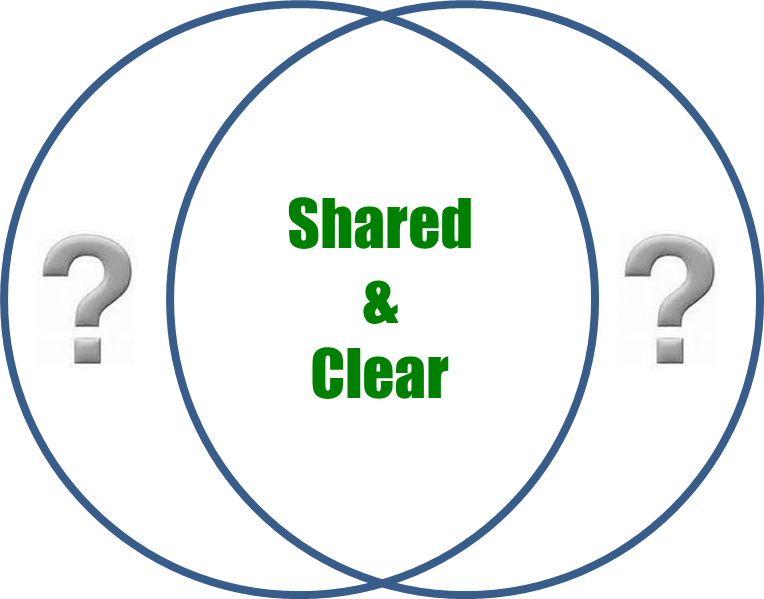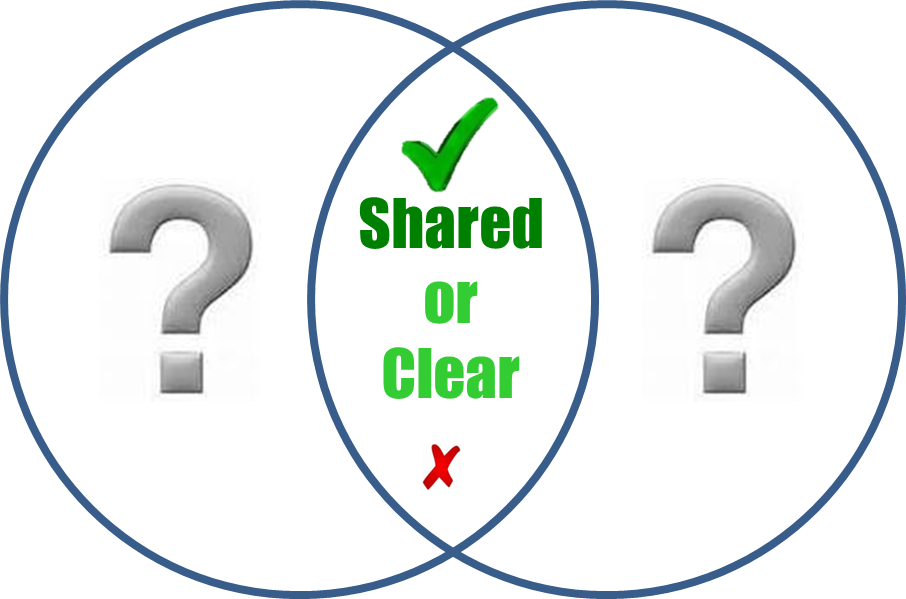When you see someone struggling or failing at communicating...
Or
When you see someone struggling or failing at performing a task efficiently and effectively...
Imagine you have in your hands a pair of special binoculars. Imagine your super-high-tech binoculars look something like this:

These special binoculars have 3 sets of dials to help you focus so you can have a clear picture of what's causing the struggling person to struggle. All those dials and gadgets are there to help you zero in on Perceptions, Intelligence, and Emotions.
When you first look into the binoculars you see two separate but overlapping pictures...one is your view and the other is the view of the person who is struggling. By adjusting the various dials you will be able to see clearly how and where your views overlap with those of the struggling person and how and where your views differ. As you begin to focus you gain comfort because you know you will be able to help the struggling person. You are on your way to understanding the common ground and the differences in Perceptions, Intelligence, and Emotions. When these things are cleared up, you will deliver your 'best help' to the struggling person.
Putting your new binoculars to work...
Operations Manual: How To Use Your New Binoculars
Step 1 - The Perceptions Dials:
Use the Perceptions Dials to remove the distortion that exists between your view of the situation and the struggling person's view of the situation.
In some situations people's perceptions have a lot of overlap...so you may not have to spend much time adjusting the Perceptions Dials. For example, if the task is being done outside and the temperature is 210 and the sun is shining through a gentle breeze then most people would agree with your perception, "This is a nice day." However, to be safe you should perform Perceptions Tests whenever time allows...and, when time does not allow, make some time.
When you first look through the binoculars the Perceptions picture will look like this:

You and the struggling person share some common ground. You can see that clearly. Around that common ground there are gray zones where your perceptions differ from those of the struggling person. You want to adjust the Perceptions Dials to remove as much of the gray zones as possible. You need to perform tests to determine whether gray zones can be cleared up...and become shared perceptions.
The best 'Perceptions Tests' are questions around the 5 human senses: sight, hearing, touch-feeling, taste, & smell...and the 6th sense - Intuition.
So to help you adjust the Perceptions Dials, ask the struggling person 3 key questions:
- What do you sense here?
- What do you see in this situation?
- What is your intuition telling you about this situation?
Listen to the answers provided by the struggling person and compare those answers to your own perceptions. Adjust your Perception Dials to find and expand the shared & clear [common] view between your perceptions and the struggling person's perceptions.
When you have adjusted all the dials, the Perceptions picture you will see:
You and the struggling person have more shared & clear perceptions and the question marks about perceptions have shrunk.Yes, you can expect gray zones around the outside...that's where your perception differences exist and where people either do not understand their own perceptions or do not communicate them...that's normal. Focus your attention on the shared & clear perceptions in the centre of the binoculars. Do not be distracted by the unknowns at the fringes.
Step 2 - The Intelligence Dial:
Use the Intelligence Dial to account for the facts (1) intelligence is multi-faceted and takes different forms and (2) people have different levels of various facets of intelligence. Some of the differences exist in areas of memory, recall, and standard logic as measured in IQ tests. Other differences exist in harder-to-quantify facets such as social intelligence. Since it is dangerous to assume actions are reliable indicators of other people's intelligence it is important to 'scope out' the differences in intelligence so you get a clearer picture of what is causing the struggling person's difficulties.
At first glance, you will see an Intelligence picture like this:

The shared & clear part of the initial Intelligence picture is larger than that of the initial Perceptions picture. That is due to the facts (1) intelligence is much easier to measure and share and (2) making judgments about intelligence and differences in intelligence are common practices whereas measuring perceptions and differences in perceptions are not.
Your Intelligence Dial has 7 trim-tabs for fine-tuning1:
- A Focus trim-tab to clarify the struggling person's ability to control his or her attention and thoughts then actions to align with goals
- An Initiate trim-tab to clarify the struggling person's ability to commence thought or action aligned with goals
- A Plan trim-tab to clarify the struggling person's ability to formulate, set, and commit to goals
- An Organize trim-tab to clarify the struggling person's ability to think about systematic, integrated actions required to achieve goals
- A Shift trim-tab to clarify the struggling person's ability to intentionally replace one thought or action with another
- A Monitor trim-tab to clarify the struggling person's ability to observe the thoughts and actions of self and others in responses to self
- A Regulate trim-tab to clarify the struggling person's ability to bring Integrity2 and order to the thoughts and actions of self
As you use these trim-tabs, discover how the struggling person answers 3 key questions:
- What do you understand about the present situation?
- What have your past experiences taught you about this sort of situation?
- How do you see this situation unfolding into the future?
As you use the 7 trim-tabs and ask the 3 key questions you will understand the shared picture of your intelligence and the struggling person's intelligence. Yes, again, there will be gray zones where your intelligence and the struggling person's intelligence differ.
When you have finished adjusting the Intelligence Dial the picture will show an enlarged shared & clear zone.
You will have identified at least 1 or 2 new ideas which now are in shared & clear view - they will shine bright like light bulbs. You will have a much clearer Intelligence picture: strengths and weaknesses will stand out as green plus signs for strengths and red minus signs for weaknesses. To the extent you can do it, you will make sure the struggling person's weaknesses are not going to blur the picture. And, you will note the strengths of the struggling person that are not in the picture now but may be relied upon in the future.
Step 3 - The Emotions Dial:
The Emotions Dial will help you understand how emotions are affecting the struggling person and, as a consequence, the situation. This is the most-tricky dial...it requires an objective yet sensitive touch. This dial may be affected by the user of the binoculars even more than it is affected by the struggling person. And, it takes time to handle this dial with skill.
When you first look into the binoculars expect the Emotions picture to look like this:
For most people, the Emotions picture is the fuzziest of the pictures...lots of gray zones of uncertainty and a smaller amount of shared or clear emotions. The Emotions Dial really requires a sensitive touch. You may find emotions are shared by the struggling person, yet you cannot identify the causes behind them. You may find the struggling person's emotions appear clear to you, yet the struggling person is not comfortable helping you as you try to clear up the picture. So, you may have to settle for shared or clear rather than shared and clear.
As you learn to master the Emotions Dial you will be able to identify positive and negative emotions and feelings and you will be able to measure the size of the emotions and feelings. To start this process, you can ask the struggling person 2 questions:
- Do you understand how you feel?
- [If Yes] How do you feel?
If the struggling person does not understand how he or she feels then you should set the binoculars down for a while. Allow the struggling person some quiet time to think about how he or she feels. Then, when the struggling person is in touch with his or her feelings, return to adjusting the Emotions Dial. As you adjust the dials, aim for clarity around emotions. Do not expect to share emotions the same way perceptions and intelligence can be shared: it is sufficient to understand emotions and identify them as good/positive or bad/negative. As you adjust the dials, keep the focus on clarity.

The goal is to keep adjusting the dials until you gain a clear picture of how the struggling person feels and how feelings, yours and the other person's, are affecting Perceptions and Intelligence. Keep adjusting the dials until the picture is clear and as shared as possible. With this done you can be confident you fully understand Perceptions, Intelligence, & Emotions...and you will help the struggling person.
Step 4 - Helping the Struggling Person
Once you have adjusted all the dials, you know the shared & clear picture of the situation at hand. You see the situation from both your viewpoint and the struggling person's viewpoint. You are now able to concentrate on the 3 most-important aspects of improving the struggling person's performance:
- putting the struggling person's talents & strengths to work,
- communicating effectively with the struggling person, &
- guiding/teaching the struggling person how to complete the task.
NOTICE to OWNER:
It will take you some time to get used to using your new, super-binoculars.
The time and attention you invest with your binoculars will determine the performance magnification you get out of them.
Footnotes:
1. These 7 trim-tabs are based on the '7 Executive BrainSmarts' presented in 'Secrets from the BRAIN', by Dr. Lorie Saxby & Phyllis Hiebert, (2010)
2. When you can express your Personal Values in writing [showing how you think the think] and
3. When you can talk with others about your Personal Values [talk the talk] and
4. When your actions are consistent with your Personal Values [walk the walk] and
5. When you acknowledge your think-talk-walk errors and strive to not repeat them
…then you have Integrity.